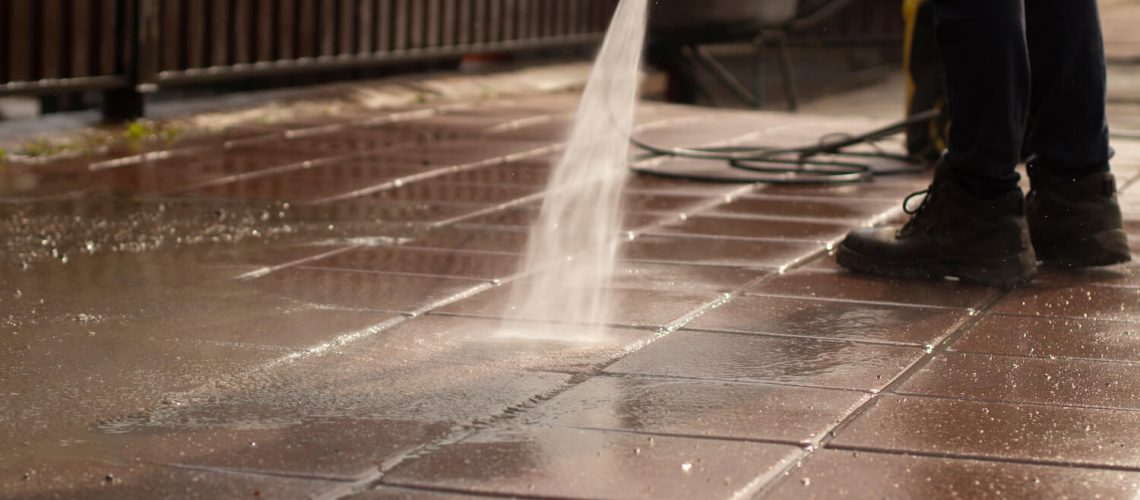Brick pavers are a timeless and durable choice for driveways, patios, walkways, and other outdoor spaces. They add a touch of elegance and charm to any property. However, to keep them looking their best and ensure their longevity, regular cleaning and maintenance are essential.
In this article, we’ll delve into the expert tips and tricks to clean and maintain your brick pavers properly and effectively.
Regular Sweeping Debris Removal
The first step in maintaining your brick pavers is to keep them free of debris. Leaves, dirt, and other organic matter can accumulate over time, leading to the growth of moss and weeds. Regular sweeping with a broom or using a leaf blower will prevent these issues and help maintain the aesthetic appeal of your outdoor spaces.
Pressure Washing
One of the most effective ways to clean brick pavers is through pressure washing. Professionals recommend using a pressure washer with a wide-angle tip to avoid damaging the surface of the bricks. Start by spraying water on the pavers to loosen any dirt or debris. Then, use a mild detergent or a specially formulated brick paver cleaner and apply it to the surface. Allow it to sit for a few minutes to break down stains and grime before using the pressure washer again to rinse the pavers thoroughly.
Stain Removal Techniques
Brick pavers are susceptible to stains from various sources, including oil, rust, and efflorescence. To tackle oil stains, sprinkle baking soda or cat litter on the affected area and let it absorb the oil. After a few hours, sweep or vacuum the residue. For rust stains, commercial rust removers are available, but a natural alternative is to mix lemon juice and salt and apply it to the stain. Allow it to sit for several hours before scrubbing with a brush and rinsing.
Efflorescence, a white powdery substance that can develop on the surface of brick pavers, is caused by the migration of salts. To remove efflorescence, brush the affected area with a stiff brush and rinse with water. Sealing the pavers after cleaning can also help prevent the recurrence of efflorescence.
Weed Control
Weeds can be a persistent issue between brick pavers. To prevent weed growth, regularly inspect the joints between the bricks and remove any emerging weeds promptly. Applying a pre-emergent herbicide to the joints can also help control weed growth. Be cautious when using herbicides, and choose environmentally friendly options if possible.
Sealing Your Brick Pavers
Sealing your brick pavers is a crucial step in maintaining their integrity and appearance. Sealing provides protection against stains, UV rays, and water damage. There are various types of sealers available, including penetrating sealers and surface sealers. Penetrating sealers are absorbed into the pavers, providing protection without altering their appearance. Surface sealers, on the other hand, create a protective layer on the surface and can enhance the color of the bricks.
Before applying a sealer, ensure that your brick pavers are clean and dry. Follow the manufacturer’s instructions for the specific sealer you choose. Typically, the application involves using a roller or sprayer to evenly distribute the sealer over the pavers. Allow sufficient drying time before walking or placing furniture on the sealed surface.
Regular Inspection for Damage
Periodic inspections of your brick pavers are crucial for identifying and addressing any potential issues before they escalate. Look for cracked or chipped bricks, uneven settling, or any signs of structural damage. If you notice any problems, consider seeking professional assistance to rectify the issues promptly.
Repairing and Replacing Damaged Bricks
Over time, exposure to the elements and heavy use can cause individual bricks to become damaged. Whether it’s a crack, chip, or complete breakage, addressing the issue promptly is essential to prevent further damage to surrounding bricks. To replace a damaged brick, carefully remove the surrounding sand or mortar, lift out the damaged brick, and insert a new one. Ensure that the replacement brick matches the existing ones in color and texture.
Re-sanding the Joints
The joints between brick pavers are filled with sand or mortar to provide stability and prevent shifting. Over time, this material can erode due to weather and foot traffic. To maintain the stability of your brick pavers, inspect the joints regularly and add additional sand or mortar as needed. Use a broom to sweep the material into the joints, ensuring an even and stable surface.
Avoid Harsh Chemicals
While it’s important to clean your brick pavers regularly, it’s equally crucial to avoid using harsh chemicals that can damage the bricks or harm the environment. Acid-based cleaners, for example, can erode the surface of the bricks and compromise their structural integrity. Stick to mild detergents or specialized brick paver cleaners recommended by professionals.
Professional Cleaning and Maintenance
For homeowners who prefer to leave the task of cleaning and maintaining brick pavers to the experts, hiring professional services is a viable option. Professional cleaning companies have the equipment, expertise, and often use eco-friendly solutions to ensure your brick pavers receive the best care without causing harm to the environment.
Seasonal Maintenance Considerations
Different seasons bring various challenges for brick paver maintenance. In colder climates, where snow and ice are prevalent, it’s essential to use caution when applying de-icing salts. Some salts can cause damage to the pavers, leading to cracks or surface deterioration. Opt for calcium magnesium acetate or sand as alternatives to traditional rock salt. Additionally, be diligent about removing snow promptly to prevent it from melting and seeping into the joints, potentially causing damage as it refreezes.
In warmer climates, where intense sunlight is a factor, consider using a UV-resistant sealer to protect the pavers from the harmful effects of prolonged sun exposure. This can help prevent fading and maintain the vibrant color of your brick pavers over time.
Treating Mold and Mildew
Mold and mildew can thrive in damp and shaded areas, especially between the joints of brick pavers. To combat these issues, mix equal parts of white vinegar and water and scrub the affected areas with a brush. This natural solution can effectively remove mold and mildew without harming the pavers or the environment. For persistent mold problems, consider using a commercial mildewcide cleaner.
Enhancing the Aesthetic Appeal
While cleaning and maintenance primarily focus on preserving the structural integrity of brick pavers, enhancing their aesthetic appeal is equally important. Consider using a color-enhancing sealer to deepen the tones of your pavers and bring out their natural beauty. This can be particularly beneficial if your pavers have faded over time due to exposure to the elements.
Sustainable Cleaning Practices
In an era where sustainability is a top priority for many homeowners, adopting eco-friendly cleaning practices for your brick pavers aligns with environmental consciousness. Choose biodegradable and phosphate-free cleaning solutions to minimize the impact on the ecosystem. Additionally, consider using a pressure washer with lower water consumption to reduce water waste during the cleaning process.
Regularly Updating and Enhancing Landscaping
The surroundings of your brick pavers play a significant role in their overall maintenance. Overgrown vegetation can contribute to the accumulation of debris and mold. Regularly trim bushes and trees near your pavers to minimize the potential for falling leaves and branches. Strategic landscaping can also provide shade, reducing the risk of intense sun exposure on the pavers.
Conclusion
In conclusion, the maintenance of brick pavers requires a combination of proactive care, regular inspections, and a commitment to environmentally friendly practices.
By following these tips from the pros, homeowners can ensure that their brick pavers not only withstand the test of time but continue to enhance the beauty of outdoor spaces for years to come. Remember, investing time and effort in the maintenance of your brick pavers is an investment in the long-term value and aesthetics of your property.

